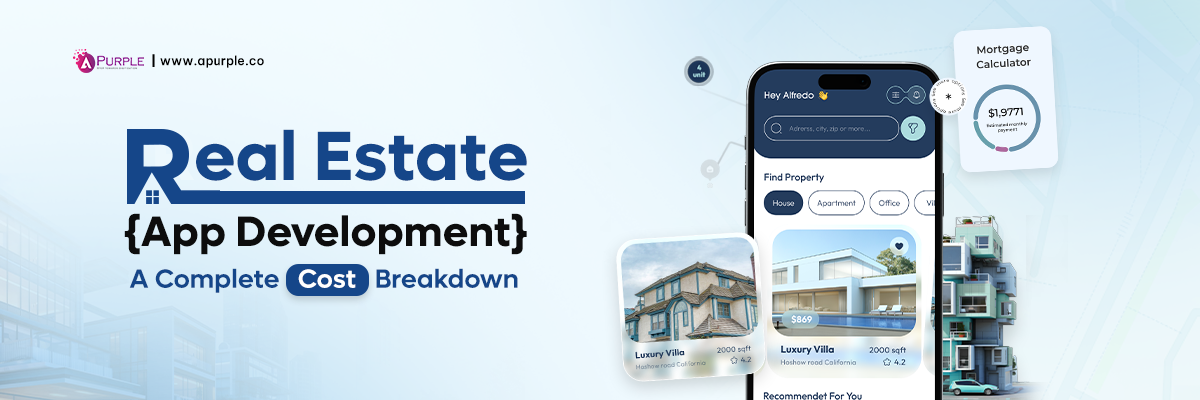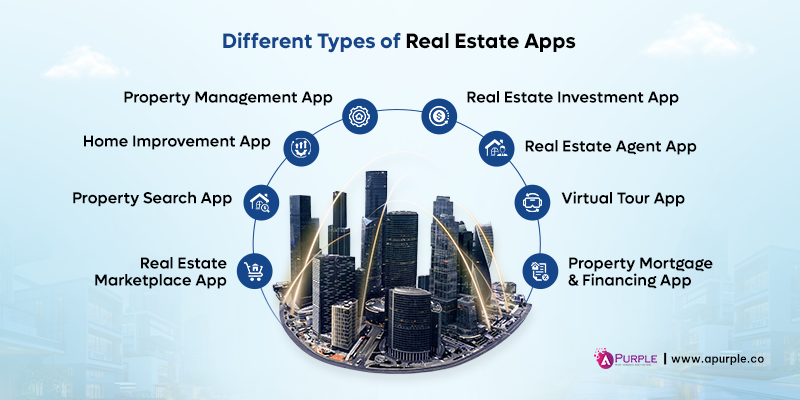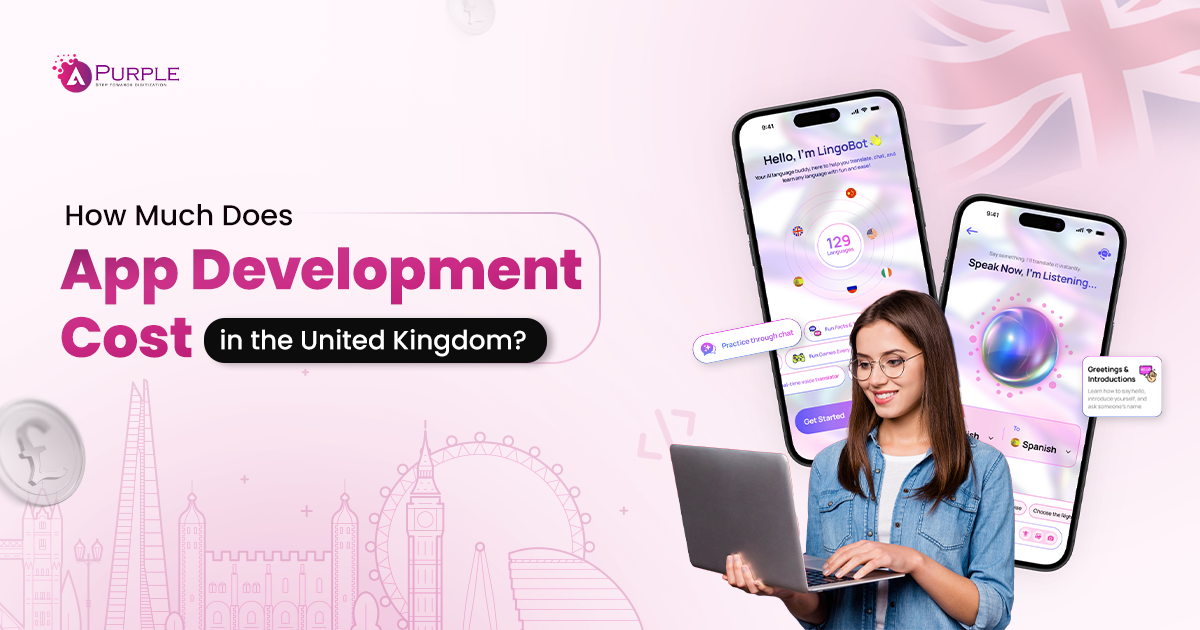
- The real estate app development cost typically ranges from USD 12,000 to USD 40,000+, depending on the app features, complexity, and other factors.
- Starting with an MVP will cost around USD 11K to USD 15,000+, which helps startups validate their real estate app idea before launching a full-scale app.
- Hidden costs like cloud storage, post-launch maintenance, and legal compliance can increase your annual budget by up to 30% if not properly planned.
- Real estate app development timelines vary, with MVPs taking 8 weeks to 6 months, while simple to complex apps may require 3 to 12+ months.
- Cutting-edge technologies like AI chatbots, AR/VR property tours, and others can significantly raise the real estate development costs and timeline.
Are you a startup founder, thinking about building a real estate app? If so, there are a few questions that must’ve come to your mind:
- What is the real estate app development cost?
- What budget should you set to develop an app like Zillow or Realtor.com?
- How long does it take to build a real estate app?
Real estate app development is about planning properly and making a budget that helps you launch your product fast and saves you from costly mistakes later.
The development cost varies depending on the features, complexity, and tech stack, from simple listing apps to fully featured real estate apps. Along with cost, the timeline is equally important to build a real estate app, the development process may take a minimum of 2 months and extend up to 12+ months.
The real estate sector is experiencing a significant digital transformation, and investing strategically in app development can position your business for long-term success.
In this blog, we will break down the development costs, timelines, and factors that affect the cost, so you can plan your real estate app smartly and launch it faster.
How Much Does Real Estate Application Development Cost?
One question that occurs in the mind of every startup founder, while planning a new real estate app, is, “What is the cost to develop a real estate app?”
The answer to this question depends on the type of app you want to build, whether an MVP, a simple app, a complex app, or an advanced AI-assisted real estate app.
In this section, we will share the real estate app development cost breakdown and the expected timeline.
| App Type | MVP | Simple App | Moderate App | Complex App | AI-Assisted App |
|---|---|---|---|---|---|
| Time-Line | 8 weeks to 6 Months | 3 to 6 Months | 5 to 7 Months | 8 to 10 Months | 10 to 12+ Months |
| Development Cost | USD 11,000 to USD 15,000+ | USD 12,000 to USD 16,000+ | USD 15,000 to USD 20,000+ | USD 25,000 to USD 30,000+ | USD 30,000 to USD 40,000+ |
Note: The cost of developing a real estate app and the timeline may vary depending on your requirements.
Expert Insights: If you are a startup founder planning to build a real estate app, we recommend you go for an MVP (minimum viable product) to validate your idea. The real estate MVP development cost is considerably lower than building a fully featured app. To do this, you can connect with an MVP development service provider.
What are the Different Types of Real Estate Apps and Their Costs?
The cost of building a real estate app depends on many factors. As an entrepreneur, you must understand the different real estate business models for startups and the development costs.
To help you with this, we have included below the most common types of real estate apps, along with details of their functionality and a breakdown of estimated costs.
1. Property Search Apps
This type of real estate app is built for users to search for properties either for sale or rent. It helps users view properties according to location, budget, and other factors.
2. Real Estate Marketplace App
It is another type of real estate app that facilitates the users to search properties, but also supports transactions like buying, selling, and renting properties.
3. Home Improvement Apps
Another type of real estate app that homeowners, tenants, or contractors use to plan, manage, and execute improvement projects. These apps bridge the gap between customers and service providers, providing tools to visualize, plan a budget, and hire professionals.
4. Property Management Apps
Another type of real estate app is the property management app. This app simplifies and automates the complex tasks involved in managing rent collection, tenant screening, financial reporting, and many other operations. In short, these apps streamline operations for property managers and landlords.
5. Real Estate Investment Apps
Real estate investment apps help users find and invest in real estate properties, including rental and commercial properties. These apps provide the feature of paying small amounts of money, known as fractional investing.
6. Virtual Tour Apps
Another type of real estate app is the virtual tour application. These applications enable users to tour properties virtually, eliminating the necessity for in-person viewings.
7. Real Estate Agent Apps
The real estate agents’ app allows agents to showcase virtual 3D tours of properties, manage documentation, and streamline various processes. This app helps reduce the time, effort, and paperwork agents require in real time. Additionally, it assists real estate agents in managing their businesses, including scheduling appointments, organizing client information, and tracking commissions.
8. Property Mortgage & Financing App
These apps simplify access to home loans by connecting users with multiple financial institutions. Moreover, these apps allow startups to offer buyers quick loan comparisons, eligibility checks, and document uploads in one place. Users can receive loan estimates based on income, credit score, and financial history, while lenders streamline approvals directly through the app.
What Factors Affect Real Estate App Development Cost?
So many factors, including real estate app functionality, platform, tech stack, and others, directly affect real estate app development costs. Additionally, selecting an experienced real estate mobile app development company can significantly impact both the cost and time of the app development process.
In this section, we have mentioned the main factors impacting the cost of designing a real estate app, which will help you properly plan and make informed decisions.
1. App Features & Functionality
The real estate app features and functionalities are important in determining the overall development cost. Basic features like login, search filters, and property listings are simple to implement.
However, advanced functionalities like AI-assistance, AR/VR tours, chatbots, and other personalized functions can significantly increase the real estate app development cost.
| Type | Cost |
|---|---|
| Basic Features | USD 9,500 to USD 20,000+ |
| Advanced Features | USD 25,000 to USD 40,000+ |
2. Platform Choices
Another factor that impacts the overall real estate development cost is the choice of platform. It will cost high if you plan to launch your application on both iOS and Android platforms.
| Platform | Estimated Cost |
|---|---|
| Single Platform | USD 12,000 to USD 25,000+ |
| Cross-Platform | USD 18,000 to USD 40,000+ |
| Native Apps | USD 30,000 to USD 40,000+ |
On the other hand, opting for cross-platform development tools like React Native can help reduce the costs. However, native app development for each platform requires more resources and effort. It is seen that a web-based application also increases the cost of development.
3. UI/UX Design
Another important factor is your real estate app’s UI/UX design. A good design will improve user engagement and trust, which is important for closing high-value real estate transactions.
The design cost varies according to your needs. For example, if you need a customized, highly interactive design with smooth navigation and advanced features that align with the current app design trends, the cost will increase and impact the overall development costs. On the other hand, simple, template-based designs will cost less.
4. App Development Team
One of the most important factors that directly impacts the cost of real estate app development is the location of your real estate app development team. Hiring developers from countries like North America, the UK, and Western Europe will typically cost more due to higher living costs. In contrast, countries like India or Eastern Europe will charge less, and you can access a large pool of skilled and experienced developers.
| Role | Full-Stack Developer | Frontend Developer | Backend Developer | Mobile App Developer | UI/UX Designer | QA Tester | Project Manager |
|---|---|---|---|---|---|---|---|
| United Kingdom | USD 50 – USD 75 | USD 45 – USD 65 | USD 50 – USD 75 | USD 55 – USD 80 | USD 45 – USD 75 | USD 40 – USD 60 | USD 50 – USD 75 |
| United States | USD 60 – USD 95 | USD 55 – USD 85 | USD 60 – USD 90 | USD 65 – USD 95 | USD 50 – USD 85 | USD 45 – USD 70 | USD 55 – USD 85 |
| Australia | USD 55 – USD 100 | USD 70 – USD 90 | USD 65 – USD 95 | USD 75 – USD 100 | USD 55 – USD 80 | USD 50 – USD 75 | USD 60 – USD 100 |
| Saudi Arabia | USD 40 – USD 65 | USD 35 – USD 55 | USD 40 – USD 50 | USD 45 – USD 65 | USD 35 – USD 55 | USD 30 – USD 55 | USD 40 – USD 60 |
| UAE | USD 45 – USD 75 | USD 40 – USD 60 | USD 45 – USD 65 | USD 50 – USD 70 | USD 40 – USD 65 | USD 45 – USD 55 | USD 45 – USD 75 |
| Singapore | USD 55 – USD 85 | USD 50 – USD 65 | USD 55 – USD 85 | USD 60 – USD 95 | USD 50 – USD 85 | USD 45 – USD 70 | USD 55 – USD 90 |
| Brazil | USD 25 – USD 55 | USD 20 – USD 40 | USD 25 – USD 45 | USD 30 – USD 50 | USD 20 – USD 50 | USD 20 – USD 30 | USD 25 – USD 65 |
Note: The above hourly rates are as per our research, they may vary depending on the team’s expertise, project type, and other factors.
5. Technology Stack & Integrations
The tech stack is another factor that directly affects the real estate app development cost. Whether you are choosing native, cross-platform, or web-based solutions, choosing the right tech is important for the future success of your real estate app. So, it is important to make the right decision as any wrong decision will directly affect money, time, and effort.
| Category | Tech Stack | Cost |
|---|---|---|
| Frontend | React Native, Flutter, React.js, Angular | USD 5,000 to USD 10,000+ |
| Backend | Node.js, Django, Laravel, Ruby on Rails | USD 5,000 to USD 12,000+ |
| Database | MySQL, PostgreSQL, MongoDB | USD 1,000 to USD 5,000+ |
| Cloud Hosting | AWS, Google Cloud, DigitalOcean | USD 2,000 to USD 5,000+ |
| Authentication | Firebase Auth, Auth0 | USD 1,500 to USD 5,000+ |
Choosing the right tech stack sets the app’s functionality and scalability. Additionally, integrating advanced technologies like AI/ML, AR/VR, and others can improve the advanced features but may also affect the overall real estate app development costs.
Advanced Technology
| Category | Tech Stack | Cost |
|---|---|---|
| Artificial Intelligence / ML | TensorFlow, PyTorch, etc | USD 5,000 to USD 10,000+ |
| AR / VR | ARKit (iOS), ARCore (Android), Unity 3D | USD 5,000 to USD 15,000+ |
| Real-Time Chat | Firebase, Socket.io | USD 1,000 to USD 3,000+ |
| Enhanced Security | SSL, JWT, AES Encryption | USD 1,000 to USD 5,000+ |
| DevOps & Cloud Scaling | Docker, AWS, Azure | USD 2,000 to USD 5,000+ |
Note: The above cost is to give you a basic idea, it may vary depending on the tech stack you choose.
6. Third-Party APIs & Tools
Integrating third-party services and APIs, such as Google Maps or payment gateway integration, may increase development costs.
| Category | Tech Stack | Cost |
|---|---|---|
| Maps & Location | Google Maps API, Mapbox | USD 2,000 to USD 4,000+ |
| Payment Gateway | Stripe, PayPal | USD 1,000 to USD 3,000+ |
| Basic Analytics | Google Analytics, Mixpanel | Free or USD 1,000+ |
| Social Media Plugins | Email, Push Notifications, Others | USD 3,000 to USD 7,000+ |
| CRM Tools | Salesforce, Zoho | USD 10,000 to USD 15,000+ |
7. App Maintenance & Updates
Continuous maintenance and updates ensure the app’s smooth performance, security, and compatibility. The after-launch maintenance process includes bug fixing, updating APIs, improving app speed, adding new features as per feedback, and responding to the users.
For startups, skipping maintenance and updates can lead to poor user experience, potential revenue loss, and higher customer turnover rates. Typically, maintenance and updates costs range from 15% to 25% of the initial development cost annually, and these costs must be included in your overall budget when planning your real estate app.
Pro Tip: Using an agile app development approach for a successful real estate app allows startups to release updates and new features iteratively. Regular maintenance and incremental improvements help keep the app secure, responsive, and aligned with user needs, reducing long-term costs and enhancing user satisfaction.
What is the Estimated Cost of Popular Real Estate Apps?
When estimating real estate app development costs, looking at popular apps across different regions is helpful. While the actual cost depends on features, technology stack, and design complexity, below are some top real estate apps and the approximate development cost.
| Country | Popular Apps | Estimated Cost |
|---|---|---|
| United Kingdom |
|
£25,000 to £200,000+ (USD 33,778 to USD 270,227+) |
| USA |
|
USD 30,000 to USD 120,000 |
| Australia |
|
USD 60,000 to USD 110,000 |
| Saudi Arabia |
|
SAR 75,000 to SAR 375,059 (USD 19,996 to USD 100,000) |
| UAE |
|
AED 146,900 to AED 1,101,749 (USD 40,000 to USD 300,000) |
| Singapore |
|
USD 75,000 to USD 150,000 |
| Brazil |
|
USD 70,000 to USD 130,000 |
Note: The above cost is based on our research and market analysis. However, the actual development cost may vary.
What are the Hidden Costs in Real Estate App Development?
When planning and calculating the real estate development cost, startups often focus on features, design, and development. However, some hidden factors can also increase the overall development cost. Ignoring these factors can significantly increase the cost of developing a real estate mobile app.
Below, we have mentioned some important hidden costs that one can keep in mind while planning the real estate app development budget:
1. App Store Fees & Compliance Costs
During the planning phase, familiarizing yourself with the policies, submission reviews, compliance, and annual developer fees for Google Play and the App Store will help you overcome the hidden costs.
- Annually, the developer account costs you $99/ year for App Store and $25 (one-time) for Google Play Store.
- In-app purchases or subscriptions may be subject to platform commission fees up to 30%.
2. Server & Hosting Charges
Real estate apps depend significantly on property images, videos, maps, and location data, which requires a strong server infrastructure.
- Cloud storage for media-heavy content increases costs.
- High-traffic spikes require scalable servers.
- Poor server choice impacts user experience.
3. Regular Maintenance & Security Updates
After launch, the app requires regular updates to fix bugs, upgrade operating systems (OS), and patch security vulnerabilities. Regular maintenance ensures that the app stays competitive and safe.
- OS updates(iOS, Android) demand frequent compatibility checks.
- Security threats require ongoing patches.
4. Marketing & User Acquisition
Developing the app is the first step, which comes with many in-house challenges, but the real struggle starts in marketing the app. Spreading your app across multiple channels requires a strategic demand and proper planning.
- Paid campaigns, such as Google Ads and social media advertising, can quickly consume budget.
- Real estate competition increases cost-per-click for ads.
- Influencer or affiliate campaigns add recurring costs.
5. Legal & Regulatory Compliance
Since real estate apps handle property transactions, contracts, and sensitive user data, staying compliant with local laws is essential. Legal issues can cause costly setbacks.
- Data privacy laws (like GDPR and CCPA) require investment in compliance.
- Real estate regulations vary across regions and markets.
- Contracts and terms of service require professional drafting.
How Can Startups Reduce Real Estate App Development Cost?
In the above section, we have mentioned the hidden factors that affect the overall real estate app development costs. But do you know, there are smart ways to reduce the real estate app development cost.
In this section, we will discuss some factors that will help you reduce the cost of real estate app development.
1. Build MVP First, Not a Full-Scale App
Instead of starting with a full-featured app, develop a minimum viable product (MVP) that focuses only on the core features. This approach will help you validate your idea at minimal cost while collecting valuable user feedback before scaling up.
2. Use Cross-Platform Frameworks (Flutter, React Native)
Developing separate native apps for iOS and Android will double the cost. Instead, opt for cross-platform frameworks like Flutter or React Native, which will help you create one code for multiple platforms, reducing both time and cost.
3. Leverage Ready-Made APIs Instead of Building from Scratch
Why create something from scratch when a solution already exists? Integrating pre-built APIs for payments, maps, or others is far more cost-effective than building custom solutions for your real estate app. Pre-built APIs will reduce the development cost, hours, and speed up the time to market.
4. Outsource to Cost-Effective but Skilled Regions
Another factor that will impact the cost of real estate app development is hiring developers. Outsourcing developers from the UK, US, or Australia can be expensive, while hiring a skilled team from regions like Eastern Europe, India, or other countries offers the same expertise with a minimum cost, making it ideal for startups.
5. Adopt Agile Development to Prioritize Features
With an agile approach, you can gradually break down your real estate project into smaller prints, focus on the most impactful features, and progressively release updates. This will ensure you are not overspending on unnecessary features early, while allowing flexibility to adapt as your app grows.
6. Use Cloud-Based Infrastructure for Scaling
Another factor that will affect the real estate app development cost is the cloud services. Using traditional cloud services will come with high costs and maintenance. Opting for cloud services like AWS, Google Cloud, or other similar services will allow you to pay only for what you use. This is a cost-friendly way to scale your real estate app as your user base grows.
Pro Tip: To build a successful real estate app, it is advised to begin with core features, scale smartly, and choose technologies that maximize the value while remaining cost-effective.
Conclusion
We hope you get a complete idea for developing a real estate app. The development process involves strategic planning around costs, timelines, and features. The complexity of your real estate app, choice of technology, and team structure are all factors that affect the overall real estate app development cost. Startups can reduce the development cost by focusing on MVP, leveraging cross-platform tools, and adopting agile methodologies.
At aPurple, we help startups in the real estate app development process, guiding them to make informed decisions and plan for long-term maintenance and scalability. By understanding the factors, startups can launch an app that meets user expectations without exceeding their budget.
With aPurple, you can confidently plan and build a real estate app that balances cost, quality, and functionality.
Frequently Asked Questions
- Begin with an MVP.
- Choose cross-platform frameworks.
- Outsourcing developers from a cost-effective region.
- Prioritize core features.
- Choose the right tech stack.
- Maintain iteratively.





